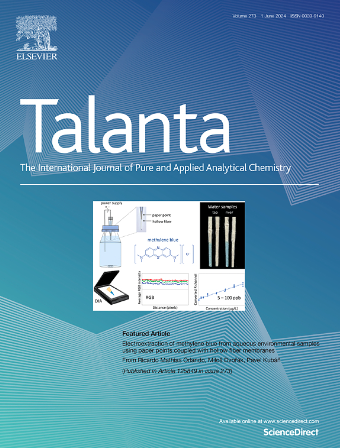Untargeted LC-MS/MS profiling and semi-quantification of Gly-Pro-Yaa and Gly-Hyp-Yaa tripeptides in collagen hydrolysates
IF 5.6
1区 化学
Q1 CHEMISTRY, ANALYTICAL
引用次数: 0
Abstract
Gly-Pro-Yaa and Gly-Hyp-Yaa are characteristic triplet sequences in collagens, and tripeptides of both types are of interest for featuring proline hydroxylation sites and quality evaluation of commercial peptide products. Current LC-MS/MS multiple reaction monitoring (MRM) methods could only detect selected Gly-Xaa-Yaa tripeptides in collagen hydrolysates owing to the limit of MRM channels. Here, an approach for simultaneous screening and semi-quantifying Gly-Pro-Yaa and Gly-Hyp-Yaa tripeptides was developed based on LC-MS/MS precursor ion scan, which provides broader analyte coverage compared to MRM's target-restricted detection. The diagnostic fragment ions at m/z 127 and 143, as well as the precursor m/z ranges of 230–336 and 246−252, were effective for detecting Gly-Pro-Yaa and Gly-Hyp-Yaa tripeptides, respectively, and there were 8 Gly-Pro-Yaa tripeptides and 12 Gly-Hyp-Yaa tripeptides screened out from 25 commercial collagen tripeptide products. By calculating the relative response factors (0.59−1.7) of six candidates, Gly-Pro-Hyp and Gly-Hyp-Ala were chosen as the preferred calibration standards for semi-quantification of individual/total Gly-Pro-Yaa and Gly-Hyp-Yaa tripeptides, respectively, with sensitivity, linearity and reproducibility validated. Gly-Pro-Hyp, Gly-Pro-Ala, Gly-Pro-Arg, Gly-Hyp-Arg, Gly-Hyp-Ala, and Gly-Hyp-Lys were abundantly found with over 70 % of the commercial products containing 1 %–9 % of any one of them. Our study provides a novel LC-MS/MS method for the characterization of X-position proline hydroxylation in collagens and for the comprehensive profiling and semi-quantification of characteristic tripeptides in commercial collagen tripeptide products.
胶原水解物中Gly-Pro-Yaa和gly - hypa三肽的非靶向LC-MS/MS分析和半定量
Gly-Pro-Yaa和gly - hypy - yaa是胶原蛋白中特色化的三联体序列,这两种类型的三肽都是用于脯氨酸羟基化位点和商业肽产品质量评价的兴趣。目前的LC-MS/MS多反应监测(MRM)方法由于MRM通道的限制,只能检测胶原水解物中特定的Gly-Xaa-Yaa三肽。本研究基于LC-MS/MS前体离子扫描,开发了一种同时筛选和半定量Gly-Pro-Yaa和gly - hy - yaa三肽的方法,与MRM的靶标限制检测相比,该方法提供了更广泛的分析物覆盖范围。诊断片段离子m/z为127和143,前体m/z为230 ~ 336和246 ~ 252,分别可有效检测Gly-Pro-Yaa和gly - hy - yaa三肽,从25个商业胶原三肽产品中筛选出8个Gly-Pro-Yaa三肽和12个gly - hy - yaa三肽。通过计算6个候选物的相对响应因子(0.59−1.7),分别选择Gly-Pro-Hyp和Gly-Hyp-Ala作为Gly-Pro-Yaa和Gly-Hyp-Yaa三肽单个/总半定量的首选校准标准,并对其灵敏度、线性度和重现性进行验证。Gly-Pro-Hyp、Gly-Pro-Ala、Gly-Pro-Arg、Gly-Hyp-Arg、Gly-Hyp-Ala和Gly-Hyp-Lys含量丰富,超过70%的商业产品含有其中任何一种的1% - 9%。我们的研究提供了一种新的LC-MS/MS方法来表征胶原中x位置脯氨酸羟基化,以及对商业胶原三肽产品中特征三肽的全面分析和半定量。
本文章由计算机程序翻译,如有差异,请以英文原文为准。
求助全文
约1分钟内获得全文
求助全文
来源期刊

Talanta
化学-分析化学
CiteScore
12.30
自引率
4.90%
发文量
861
审稿时长
29 days
期刊介绍:
Talanta provides a forum for the publication of original research papers, short communications, and critical reviews in all branches of pure and applied analytical chemistry. Papers are evaluated based on established guidelines, including the fundamental nature of the study, scientific novelty, substantial improvement or advantage over existing technology or methods, and demonstrated analytical applicability. Original research papers on fundamental studies, and on novel sensor and instrumentation developments, are encouraged. Novel or improved applications in areas such as clinical and biological chemistry, environmental analysis, geochemistry, materials science and engineering, and analytical platforms for omics development are welcome.
Analytical performance of methods should be determined, including interference and matrix effects, and methods should be validated by comparison with a standard method, or analysis of a certified reference material. Simple spiking recoveries may not be sufficient. The developed method should especially comprise information on selectivity, sensitivity, detection limits, accuracy, and reliability. However, applying official validation or robustness studies to a routine method or technique does not necessarily constitute novelty. Proper statistical treatment of the data should be provided. Relevant literature should be cited, including related publications by the authors, and authors should discuss how their proposed methodology compares with previously reported methods.
 求助内容:
求助内容: 应助结果提醒方式:
应助结果提醒方式:


